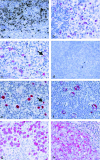Epstein-Barr virus infection and human malignancies
- PMID: 11488990
- PMCID: PMC2517709
- DOI: 10.1046/j.1365-2613.2001.iep0082-0149-x
Epstein-Barr virus infection and human malignancies
Abstract
The Epstein-Barr virus (EBV) is a herpes virus which establishes a life-long persistent infection in over 90% of the human adult population world-wide. Based on its association with a variety of lymphoid and epithelial malignancies, EBV has been classified as a group 1 carcinogen by the International Agency for Research on Cancer. In this article we discuss the evidence supporting an aetiological role for EBV in the pathogenesis of human tumours. The biology of EBV infection will be described with special emphasis on viral transforming gene products. A brief survey of EBV-associated tumours is followed by a discussion of specific problems. Evidence is presented which suggests that failures of the EBV-specific immunity may play a role in the pathogenesis of EBV-associated tumours also in patients without clinically manifest immunodeficiencies. Finally, the timing of EBV infection in the pathogenesis of virus-associated malignancies is discussed. There is good evidence that EBV infection precedes expansion of the malignant cell populations in some virus-associated tumours. However, this is clearly not always the case and for some of these tumours there are indications that clonal genetic alterations may occur prior to EBV infection. Thus, whilst there is good evidence to suggest that EBV is a human carcinogen, its precise role(s) in the development of virus-associated human tumours requires clarification.
Figures

References
-
- Abdulkarim B, Sabri S, Deutsch E, et al. Radiation-induced expression of functional Fas ligand in EBV-positive human nasopharyngeal carcinoma cells. Int. J. Cancer. 2000;86:229–237. 10.1002/(sici)1097-0215(20000415)86:2<229::aid-ijc12>3.3.co;2-t. - DOI - PubMed
-
- Agathanggelou A, Niedobitek G, Chen R, Nicholls J, Yin W, Young LS. Expression of immune regulatory molecules in Epstein-Barr virus-associated nasopharyngeal carcinomas with prominent lymphoid stroma. Evidence for a functional interaction between epithelial tumor cells and infiltrating lymphoid cells. Am. J. Pathol. 1995;147:1152–1160. - PMC - PubMed
-
- Aiyar A, Tyree C, Sugden B. The plasmid replicon of EBV consits of multiple cis-acting elements that facilitate DNA synthesis by the cell and a viral maintenance element. EMBO J. 1998;17:6394–6403. 10.1093/emboj/17.21.6394. - DOI - PMC - PubMed
-
- Ambinder R, Browning PJ, Lorenzana I, et al. Epstein-Barr virus and childhood Hodgkin's disease in Honduras and the United States. Blood. 1993;81:462–467. - PubMed
Publication types
MeSH terms
Substances
LinkOut - more resources
Full Text Sources

